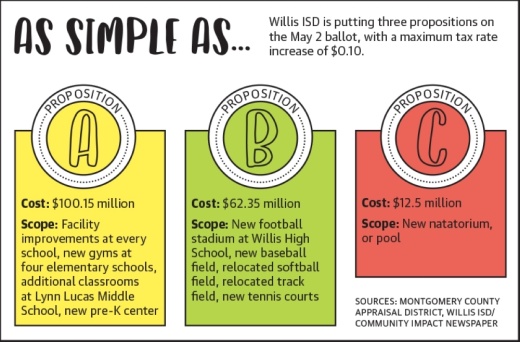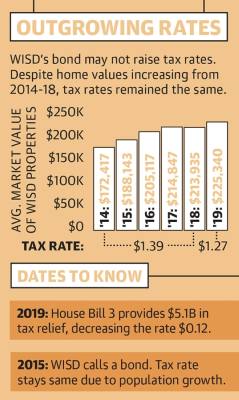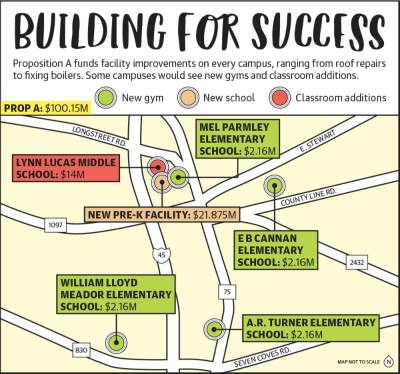Alongside lacking a natatorium, WHS athletes, including football players, must use crowded locker rooms, said Clark, who is also on the WHS football team.
“The students and definitely the parents have done more than enough to grow this team,” he said. “I think it’s time for the district to do their part.”
Willis ISD is bringing the issues to voters May 2 in the form of three bond referendums totaling $175 million. The board called for a bond election Feb. 10, putting three propositions on the ballot: $100.15 million Proposition A, which focuses on school improvements; $62.35 million Proposition B, which includes a new football stadium; and $12.5 million Proposition C, which would fund a natatorium.
District officials said WISD would not increase the tax rate more than $0.10 per $100 valuation to pay for the bonds, if approved.
WISD Superintendent Tim Harkrider said the bonds are necessary to fund projects and needed improvements that fall outside of the district’s annual budget.
“We do things for maintenance without bonds. We budget these every year,” Harkrider said. “But it came to a point where we’ve got almost 30 items ... on what needs to be done in the next three years.”
The district also examined growing student enrollment when considering its need for a bond election, he said. WISD had 7,493 students in 2018-19, compared to 7,275 in 2017-18, according to the Texas Education Agency. District officials said the district is expected to grow an average of 5.39% every year in the next five years.
Although a tax rate increase is not official and the district has remaining debt from previous bonds, WISD parents, students and alumni have spoken in favor of the bond package, pointing toward the improvements the projects would bring to the district and its students.
Schools, sports and swimming
Harkrider said the process to create the bond package began in May, when the WISD Long Term Planning Committee convened. The group met monthly to review the district’s budget, demographics, updated student enrollment and future projected growth. The board of trustees approved the bond package Feb. 10.
The $100.15 million Proposition A includes adding new gym spaces to Parmley, Cannan, Meador and Turner elementary schools as well as funding a $14.06 million, two-story addition of 18 classrooms at Lynn Lucas Middle School. Harkrider said the expansion will create a “science wing” at Lynn Lucas, making room for 400 additional students.
The district will also build a new full-day pre-K center with Proposition A bond funds to house about 400 pre-K students for $21.875 million, Harkrider said. House Bill 3, which was signed into law June 11 by the Texas Legislature, requires districts to provide full-day pre-K to qualifying students.
Other projects from Proposition A include campus improvements to every school in the district, from roof replacements to HVAC upgrades.
The $62.35 million Proposition B mainly serves to create a new football stadium at WHS, Harkrider said. The district’s current football stadium, Yates Stadium, was built in 1974 and seats about 2,400 people. The proposed stadium would increase the seating capacity to 7,500. The $50 million designated for the stadium is on par with what several other nearby school districts have spent to fund new football stadiums, such as Spring ISD’s $38 million stadium in 2016, Tomball ISD’s $51.2 million stadium in 2017, and Conroe ISD’s $40 million south Montgomery County stadium in 2008.
However, Harkrider said WISD’s Proposition B also includes relocating the baseball and softball fields to make room for the new stadium.
On Feb. 3, WISD was reclassified as a 6A school district—the largest conference meant for school districts with more than 2,100 students—by the University Interscholastic League, which governs all athletic, musical and academic contests in Texas. Lisa Bardwell, a WISD mother of two athletes, said she is dreading the first game WHS has this year against The Woodlands High School football team due to limited space.
“Their football team is like triple the size of ours. It probably won’t fit in our locker room,” Bardwell said. “But their band and drill team alone will take up 50% of that stadium.”
Under the $12.5 million Proposition C, the district would also build a new, 20,000-square-foot natatorium that would seat 155 spectators and two high school teams.
Lauren McClatchy, a former WHS swimmer of the class of 2019, said having a natatorium on campus would greatly improve practice time. She said the team had to share the Conroe Recreation Center with a club team and could only practice for a short time due to sharing the pool and the commute.
To tax or not to tax
WISD’s current tax rate is $1.27 per $100 valuation, and the district projects a maximum $0.10 increase to fund the bonds if they are approved.
Harkrider said the district cannot determine yet if the increase will be necessary. The rate increase is based on a projected 8% growth in property value over the next five years followed by no growth every year after, he said. However, Harkrider said this estimate is conservative.
“Obviously we know ... we’re not going to have 0% property value growth,” Harkrider said.
When the district called for a $109.5 million bond in 2015, the proposed maximum tax rate increase needed to help fund the bond was $0.0675. However, due to population growth and property value increases, Harkrider said no increase was necessary to pay for the bond debt.
According to the Montgomery Central Appraisal District, WISD grew from 26,674 accounts in 2014 to 27,074 in 2015. The accounts are all the residential, commercial or business properties within the district. In 2019, the office had 29,624 accounts on the appraisal roll.
From 2013 to 2018, WISD maintained the same tax rate of $1.39. HB 3, which provided Texas districts $5.1 billion in tax relief, brought the district’s $1.39 tax rate down $0.12 on June 11, said Abbie Holland, a member of the planning committee.
The current tax rate of $1.27 is the lowest WISD has had in 11 years, according to the district.
The district still has an existing bond debt of $223.76 million from previous bonds, Harkrider said. But the new proposed bonds would not be sold at the same time, and it would take the district about four years to sell them, he said.
As the district sells bonds and the area grows, Harkrider said it will be strategic in how it sells the bonds to have the least effect on taxpayers.
Sonny Flippo, a resident of Point Aquarius in Willis, said he believes any potential increase will be used to improve the district.
“We are investing in our kids and our community, and the future of both,” Flippo said. “If you are vested in our kids and their future, then voting ‘yes’ is an easy choice.”







